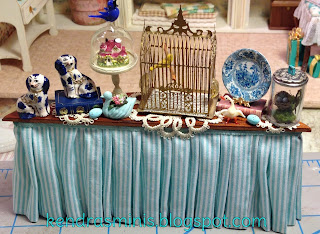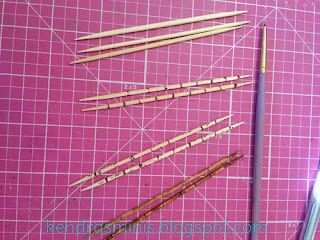It’s been a long time since I last blogged. I promised to show some more items from the interior of my antique shop (which I will, below) but first – I wanted to tell how I made my “Blue Egg Antique Shop” sign.
Shop Sign (mini) Tutorial:
The egg shape was cut out of foam core. I printed the words using Microsoft Word and WordArt (see file here):Antique Shop Sign Word_Document
WordArt is a program embedded into Microsoft Word that allows you to change the angle, stretch, squeeze, etc. If you have Word you can use the above file and just edit the letters, colors, font, etc.
I glued the lettering to the egg and added a few 'shadow' strokes in brown then painted a light blue (sort of dry brushed) around the outside of the egg leaving the inside white. To cover the foam core edge I glued on a flat gold braid. I cut a small gold foil 'Dresden' decoration (see Ebay) in half and glued it to both ends of the egg.
The fancy rectangle frame is from metal miniatures (metalminis.com – see others described below). I usually wash, dry and spray all metal minis with a flat white spray paint before painting with acrylics. This frame was painted with gold acrylic (Decoart brand “Emperor’s Gold” Dazzling Metallics). After that dried I antiqued the frame with antiquing glaze (also acrylic – sold with the acrylic paints in craft stores). To use the antiquing glaze you paint over the entire frame then quickly wipe off with a paper towel. I have to admit the frame really looked like an antique gold frame when I was done. Be careful not to antique before the first coat of paint is very dry or it will just rub the first coat off.
I filled in the back of the rectangle with just cardboard painted blue then glued the egg right on front of the frame.
Now for some interior photos promised last JUNE! (sorry)
On the left side of the shop is a desk and wrapping paper holder (to gift wrap all those purchases). The desk was purchased but I think it was a laser kit. On the shelves:
Top shelf - several figures purchased on Ebay
Middle shelf - two bowls made from filigree findings painted shabby pink, lamps from ceramic beads, a tiny painted metal elephant (Metal minis #368 sm) and a purchased pitcher.
Bottom shelf - two painted shabby candlesticks (metal minis # 684) with added bobeches from jewelry findings, Elaine Cannon doll in dome (vintage).
Center post - two petit point silhouettes (Ebay) framed with faux bamboo frames (see my earlier blogs).
In the CENTER section of the shelves:
Top Shelf l to r- cruets made from glass beads (Spanish Miniatura magazine), painted platter (metal minis # 47), porcelain "Aladdin" teapot.
Middle Shelf - so many clocks, most are painted metal (see item numbers below). Two smaller ones near front are made from findings. (Metal Minis clocks back row left: gold #934A, center gold #85, right beige/blue vase #100. Front row left center small blue #934X, right gold alarm clock #426 lg, blue alarm clock #426 sm).
Bottom Shelf - gold leafed frame (metal minis # 463), lamp from bead, painting and Kummerows bird cage.
Center post (right) - framed signs, top one is metal minis # 806A, the other one I don't know where it was from.
Right side of shop, shelves:
Top Shelf: salt & pepper from beads (a tote bag item from this event), Staffordshire dogs - painted metal minis #725.
Middle shelf: Chrysnbon decanter set and bowl of flowers
Bottom shelf: elephant figures (Ebay), finch egg with glass elephant (made by me years ago).
On and around the chair:
The petit point rug was an estate find. It was unfinished so I rolled it up and put a price tag on it. The petit point picture on the wall was by Ligia Durstenfeld (60 count) framed in faux bamboo. The chair was also an estate purchase - I added the skirt and padded seat. The box I made using Microsoft Word and printed on heavy paper. I also wrapped the packages.
Front Window Display:
Tatted doilies were made by my friend, Karen Haggard. Another pair of Staffordshire dogs - painted metal minis. The swan planter is also a metal mini. Other items were show purchases or Ebay. The house under the dome is by Sylvia Mobley on a pedestal by Eurosia. The glass bird dome and blown glass goose were Ebay purchases. Brass bird cage is a vintage Kummerows piece. Plate was purchased on Etsy from A Lavender Dilly. The canister with bird nest inside was made from plastic tubing and a button top.
Last photo - the door and one more metal miniature: frame #767 (Open sign). The shop hours sign was a tote bag item.
Better late than never (getting back to my blogging). I'll have one more mini tutorial from this project on how to make the tiny price tags and a plate stand hint. Thanks to all those of you who follow my blog and for your nice comments, too.
Merry Christmas!
Kendra




















































